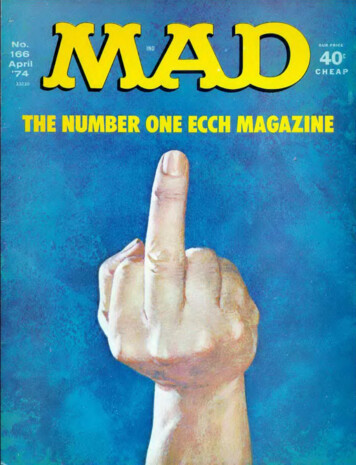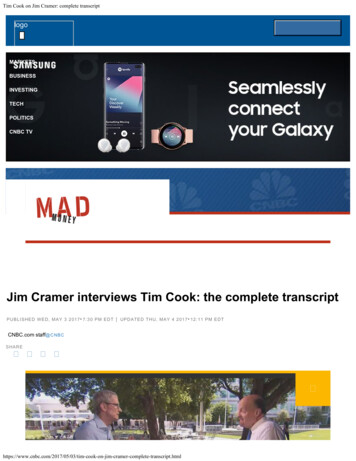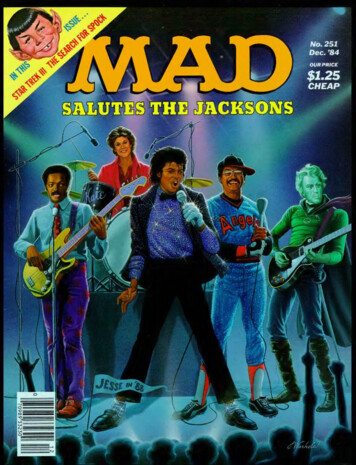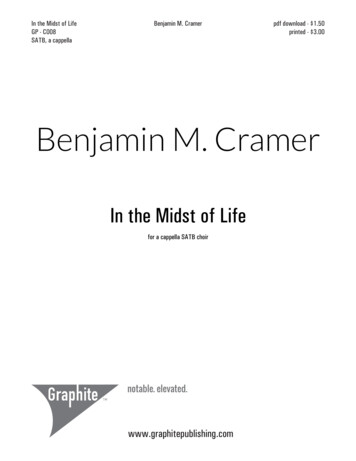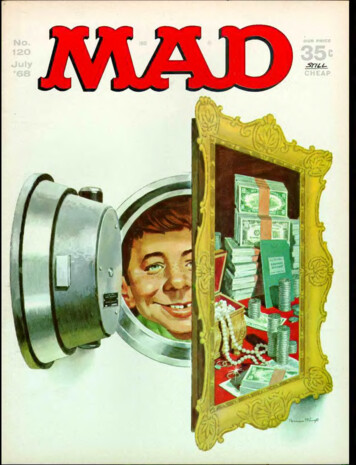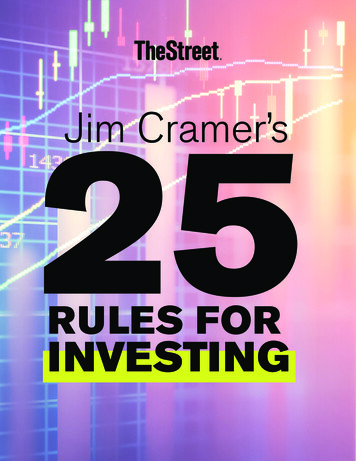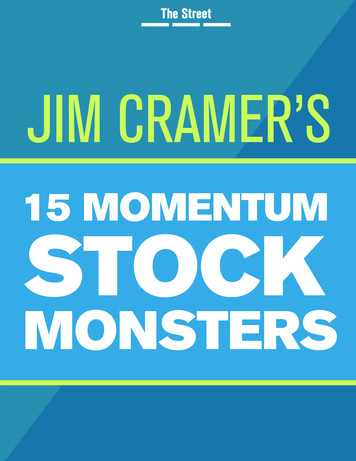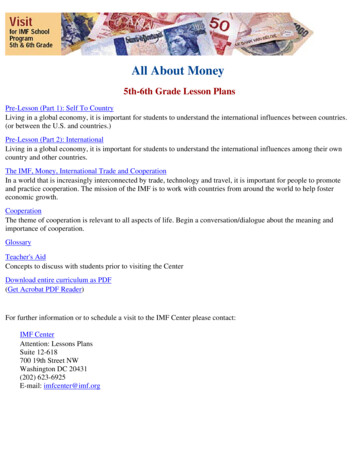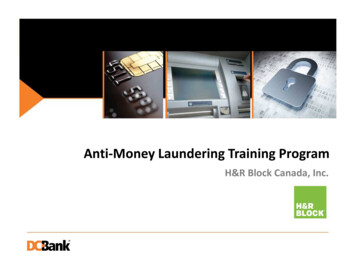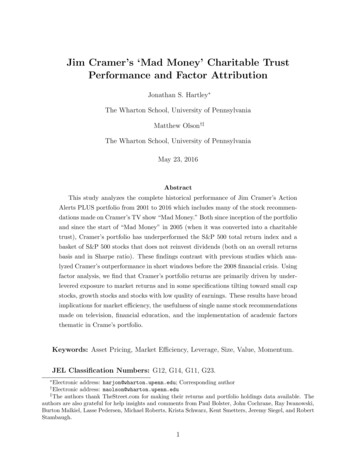
Transcription
Jim Cramer’s ‘Mad Money’ Charitable TrustPerformance and Factor AttributionJonathan S. Hartley The Wharton School, University of PennsylvaniaMatthew Olson†‡The Wharton School, University of PennsylvaniaMay 23, 2016AbstractThis study analyzes the complete historical performance of Jim Cramer’s ActionAlerts PLUS portfolio from 2001 to 2016 which includes many of the stock recommendations made on Cramer’s TV show “Mad Money.” Both since inception of the portfolioand since the start of “Mad Money” in 2005 (when it was converted into a charitabletrust), Cramer’s portfolio has underperformed the S&P 500 total return index and abasket of S&P 500 stocks that does not reinvest dividends (both on an overall returnsbasis and in Sharpe ratio). These findings contrast with previous studies which analyzed Cramer’s outperformance in short windows before the 2008 financial crisis. Usingfactor analysis, we find that Cramer’s portfolio returns are primarily driven by underlevered exposure to market returns and in some specifications tilting toward small capstocks, growth stocks and stocks with low quality of earnings. These results have broadimplications for market efficiency, the usefulness of single name stock recommendationsmade on television, financial education, and the implementation of academic factorsthematic in Crame’s portfolio.Keywords: Asset Pricing, Market Efficiency, Leverage, Size, Value, Momentum.JEL Classification Numbers: G12, G14, G11, G23. Electronic address: harjon@wharton.upenn.edu; Corresponding authorElectronic address: maolson@wharton.upenn.edu‡The authors thank TheStreet.com for making their returns and portfolio holdings data available. Theauthors are also grateful for help insights and comments from Paul Bolster, John Cochrane, Ray Iwanowski,Burton Malkiel, Lasse Pedersen, Michael Roberts, Krista Schwarz, Kent Smetters, Jeremy Siegel, and RobertStambaugh.†1
1IntroductionThe usefulness of the financial advice from CNBC financial markets commentator JimCramer and other television finance personalities has historically been one of controversy.Cramer, unlike many other TV finance personalities, actually manages a stock portfolio thatinvests in many of his stock recommendations made on his television show Mad Money.Initially established in August 2001 with approximately 3 million (according to Cramer’sGet Rich Carefully), TheStreet.com’s Action Alerts PLUS (AAP) Portfolio has been thecenterpiece of TheStreet.com’s financial advice, giving subscribers access to each trade theportfolio makes ahead of time. In March 2005 at the launch of Cramer’s CNBC TV showMad Money, the Action Alerts PLUS Portfolio was converted into a charitable trust, andadopted the policy that any dividend or other cash distributions would be donated to charity.The portfolio has had relative stability in terms of its management over time, while Cramerlists himself as a “co-portfolio manager” of the Action Alerts PLUS Portfolio. Recentlyin February 2015, Stephanie Link, the other Action Alerts PLUS Portfolio “co-portfoliomanager” left TheStreet.com to join TIAA- CREF, being replaced by Jack Mohr.While previous papers have examined Cramer’s pre-financial crisis portfolio returns (Bolster and Trahan (2009)) or the market impact of his stock recommendations made on TV(Engelberg and Parsons (2011)), this is the first paper to fully examine the entire historyof Jim Cramer’s Action Alerts PLUS portfolio returns before and after the financial crisis,adding seven years of post-financial crisis returns data from Cramer’s Action Alerts PLUSportfolio. Further, this is the first paper to test for the potential presence of quality (QMJ)and betting against beta (BAB) factors in Cramer’s portfolio, in addition to the traditionalleverage (MKT-Rf), size (SMB), value (HML) and momentum (UMD) factors. We takethe same approach as that of Frazzini, Kabiller and Pedersen (2012), who analyze the riskfactors underlying Warren Buffett’s entre portfolio return history at Berkshire Hathaway.We find that Cramer’s AAP has underperformed the S&P 500 total return index and abasket of S&P 500 stocks that does not reinvest dividends both since inception of the portfolio2
and since the inception of Mad Money. In addition, Cramer’s portfolio has a lower Sharperatio than both benchmarks over the same time period. We also find over the portfolio’sentire history that Cramer’s AAP portfolio exposures are primarily driven by underleveredexposure to market returns (MKT-Rf) in every specification, which has heavily contributedto underperforming the S&P 500 in post-financial crisis years. In other specifications, wefind evidence of a tilt toward small cap stocks, growth stocks, and stocks with low qualityof earnings. Also, when controlling for various factors in various specifications, the negativealpha (intercept) from the regression no longer becomes statistically significant. The paperproceeds as follows: Section 2 reviews the literature, Section 3 presents the data and ourempirical strategy, Section 4 reviews the results and Section 5 concludes.2LiteratureSeveral papers examine the short-term market impact of Jim Cramer’s stock recommen-dations. Engelberg and Parsons (2011) and Engelberg et al. (2012) disentangle the causalimpact of media reporting from the impact of the events being reported. The authors thenfind that average abnormal overnight returns following his recommendations are over 3% fortheir entire sample and over 6% for stocks in the smallest quintile. The authors also findthat the price response is increasing in the number of wealthy viewers who watch the showbut are unaffected by the number of low income households viewing the recommendations.The main thrust of this study, however, is in determining whether or not certain stock recommendations are more impactful than others, and whether or not the segment of the showin which the recommendation appears is priced. Results of this study can be used to makeinferences regarding the efficiency by which information promoted via a popular televisionshow may influence investor behavior (i.e. price discovery, market liquidity, market volatilityand trading volume). Expanding on the findings of Neumann and Kenny (2007), Engelbergand Parsons (2011), and Engelberg et al. (2012), results from this study can be used to3
determine if media endorsements of individual stocks lead to mispricing, and whether or notthe retail investor is bearing that cost. The implications of this research have the potentialto reposition prior research and to augment future thrusts in financial market research.Instead, this paper seeks to examine the long-term performance of Cramer’s stock recommendations, in particular the performance of Cramer’s Action Alerts PLUS portfolio,commonly referred to as his charitable trust, which invests in the recommendations thathe makes on Mad Money. This paper builds on Bolster, Trahan and Venkateswaran (2012)and Bolster and Trahan (2009), adding seven years of post-financial crisis returns data fromCramer’s Action Alerts PLUS portfolio. In addition, we test for the presence of other factors such as the Betting Against Beta (BAB) factor of Frazzini and Pedersen (2014) andthe Quality Minus Junk (QMJ) quality factor of Asness, Frazzini and Pedersen (2013). Nostudies to our knowledge analyze the performance of Jim Cramers charitable trust (ActionAlerts PLUS portfolio) since its inception through the post-Great Recession crisis period.Bolster, Trahan and Venkateswaran (2012) analyzing Cramers Mad Money buy and sellrecommendations between July 28, 2005 (the beginning of Cramers show Mad Money) andDecember 31, 2008, find that the recommendations can impact the share prices of companiesthat he mentions. Their factor analysis suggests his returns are driven by beta exposure,smaller stocks, growth-oriented stocks and momentum effects. Their analysis is limited to3.5 years from 2005 to 2008 and does not observe returns during a full recession period. Inaddition, they do not regress on any BAB or quality factors.3Data and Empirical Strategy3.1Action Alerts PLUS Portfolio (Mad Money ‘CharitableTrust’) Returns DataReturns data from the Action Alerts Portfolio PLUS are provided by TheStreet.comwhich are also made available to the public (See Table 1, Figure 1). Subscribers are also4
given access to portfolio holdings data which we use to confirm some the findings of our riskfactor analysis.3.2CRSP Mutual Fund DataWe also compare Cramer’s returns to the active equity mutual fund universe. To do so,we obtained the returns from the CRSP Mutual Fund database for all active equity mutualfunds that were active during some period between August 2001 and December 2015 (seeFigure 2).3.3Factor Data and AnalysisIn our factor analysis of Cramer’s Action Alerts PLUS Portfolio excess returns (Rp,t Rf,t ),we run several specifications using popular academic factors. We also run the regressions overtwo key time periods. First, we run regressions from the inception of the Action Alerts PLUSPortfolio in August 2001 to March 2016. We also we run regressions from the beginning ofMad Money in March 2005 (the same time the portfolio was converted into a charitabletrust) to March 2016.This includes the CAPM (Equation 1) regressing Cramer’s excess returns on a leveragefactor (MKTRf) defined by the S&P 500 minus the risk-free 3-month T-bill rate:(Rp,t Rf,t ) α β (Rm,t Rf,t ) t(1)Our analysis also includes a Fama-French (1993) Three Factor Model (Equation 2) thatregresses Cramer’s excess returns on a leverage factor (MKTRf) in addition to size (SMB)and value (HML) factors obtained from the Ken French data library:(Rp,t Rf,t ) α βMKT (Rm,t Rf,t ) βSMB SMBt βHML HMLt t(2)We run another specification using the Carhart (1997) Four Factor Model (Equation 3) that5
includes a momentum factor (UMD), also obtained from the Ken French data library:(Rp,t Rf,t ) α βMKT (Rm,t Rf,t ) βSMB SMBt βHML HMLt βUMD UMDt t (3)In separate specifications, we also regress Cramers excess returns on the Frazzini andPedersen (2014) Betting-Against-Beta factor and the Asness, Frazzini and Pedersen (2013)Quality Minus Junk (QMJ) factor.4Results4.1Factor AttributionThe results of the regressions are reported in Table 3. Analyzing the entire history of theportfolio, our CAPM specification finds a CAPM Beta of approximately 0.95 (statisticallysignificant at the 1% level) and a negative alpha of -2.38% that is statistically significant (atthe 10% level). Being underleveraged (underinvesting in the market portfolio) in part maybe a result of the portfolios policy of not reinvesting cash dividends. Across almost all ofour specifications, the results demonstrate that underleverage explains most of the portfolios relative underperformance given the S&P 500’s positive absolute performance over theperiod. This is also confirmed by the portfolio holdings data which indicates that the AAPportfolio often holds a significant cash position, largely to make its annual cash distributionin March to make charitable contributions.In our Fama-French (1993) three factor specification, we do find that the portfolio hassome exposure to small caps given that the SMB factor is statistically significant at the 10%level, something confirmed by the portfolio holdings data. We do not find such a statisticalsignificance when only looking at the entire history of Mad Money from 2005. Also, whencontrolling for momentum factors in our Carhart (1997) four factor specification, statistical6
significance of the size factor also disappears nor do we find evidence of statistically significant exposure to momentum stocks. However, we do find that when analyzing the March2005 to March 2016 time period, when adding the extra size, value and momentum factorsin the Fama-French (1993) and Carhart (1997) four factor regressions that the statisticalsignificance of the negative alpha of -3.06%, found in the CAPM for the same period, disappears. When we include the Frazzini and Pedersen (2014) Betting-Against-Beta factor andthe Asness, Frazzini and Pedersen (2013) Quality Minus Junk (QMJ) factor, we find someevidence that Cramer tilts toward growth stocks and away from stocks with high quality ofearnings.4.2Factor ReplicationUsing the factor analysis results obtained above, we also construct a “robo-Cramer portfolio that uses the same factor loadings as estimated from the regressions (Figure 3). Thesystematic Cramer-style portfolio is constructed from the same regressions of monthly excessreturns in 3.2, namely the Carhart Four Factor regression using data over the entire time period (August 2001 to March 2016). The portfolio is rebalanced annually at year-end to keepconstant weights. The explanatory variables are the monthly returns of the standard size,value, and momentum factors. Note that such a synthetic portfolio outperforms Cramer’sactual cumulative returns for the entire period.4.3Financial Education and Portfolio DiversityThere is an important question of how many viewers have used Cramer’s financial advicein their own portfolio decisions. Ratings from Nielsen (Figure 4) indicate the number ofMad Money viewers has waned in recent years. Analyzing TheStreet.com’s public financialdisclosures also provides some insight into the number of subscribers potentially taking JimCramer’s stock advice provided through this Action Alerts PLUS Portfolio, which sendsdaily stock pick updates to viewers. TheStreet.com (TST) held its IPO at the height of the7
tech bubble in 1999 and while remaining a public company, stock price has fallen as well(Figure 5). However, revenue for subscriptions to TheStreet.com’s subscriptions has steadilyrisen (Figure MISSING FIG), indicating that consumers may not be responding to waningperformance relative to the S&P 500. Cramer’s Get Rich Carefully suggests that the numberof subscribers (who pay roughly 15 a month or more) is in the millions.While our study shows what viewers’ portfolios would have returned should they perfectlyfollow Cramer’s Action Alerts Plus Portfolio, we also need to consider the possibility thatviewers or subscribers do not diversify their portfolio, adding idiosyncratic risk. In fairness,Cramer has consistently advocated for diversification both on Mad Money and in other forms,more specifically advising that anyone with less than 10,000 in liquid assets should buy amutual fund, index fund or ETF. Financial literacy research on diversification in recent yearshas asked respondents the question: “Do you think that the following statement is true orfalse: ‘Buying a single company stock usually provides a safer return than a stock mutualfund.’” Lusardi and Mitchell (2012) examining older respondents aged 50-69 in the Healthand Retirement Study of 2004 find 52.3% answered correctly, 13.2% incorrectly and 34.6%said they didn’t know or refused. Lusard, Mitchell and Curto (2011) examining youngerrespondents aged 23-28 in the National Longitudinal Survey of Youth in 2007-2008 find46.8% answered correctly, 15.8% incorrectly and 37.3% said they did not know or refused.CNBC has responded to concerns about consumer protection by placing extensive disclosures at the introduction of each episode of Mad Money and during commercial breaks.Indeed, CNBC at present requires Cramer to not trade any stock picks he recommends onhis show for 5 days after in 2005 he was temporarily banned from the network for “talkinghis book.” While some have advocated banning various forms of televised investment adviceto protect individuals with little knowledge, education or information, this question alongwith others about consumer protection outside the scope of this paper.8
5ConclusionThis paper is the first study to analyze Jim Cramer’s Action Alerts PLUS Portfolioreturns over its entire history with data from post-financial crisis years. Previous studieshave only analyzed various periods of out-performance leading up to the financial crisis. Wefind that the portfolio’s overall under-performance relative to the S&P 500 is primarily drivenby being underlevered to the market portfolio. Such underleverage has allowed the portfolioto miss out on substantial upside in post-crisis years. In various specifications, we also findsome evidence of exposures to small cap stocks, growth stocks and stocks with low quality ofearnings. Since unlike previous papers which find out performance in pre-crisis years, addingpost-crisis years we find that Cramer has under-performed the S&P 500 since the inception ofhis portfolio and the inception of Mad Money even when controlling for leverage and otheracademic factors, this arguably has certain implications for star performance and marketefficiency theory. These results also have several implication TV stock advice disclosurepolicy and financial education, which is outside the scope of this paper.AppendixReferencesAnnamaria Lusardi, Olivia S. Mitchell (2011), Financial Literacy and Retirement Planningin the United States, Journal of Pension Economics and Finance, October: 509-525.Asness, C., A. Frazzini, and L. H. Pedersen (2012a), Leverage Aversion and Risk Parity,Financial Analysts Journal, 68(1), 47-59.Asness, C., A. Frazzini, and L. H. Pedersen (2013), Quality Minus Junk, working paper,AQR Capital Management, New York University.9
Black, F. (1972), Capital market equilibrium with restricted borrowing, Journal of Business,45, 3, pp. 444-455.Bolster, Paul, Emery Trahan, Anand Venkateswaran. How Mad Is Mad Money: Jim Crameras a Stock Picker and Portfolio Manager, Journal of Investing, May 2012.Bolster, P.J., and Trahan, E.A. Investing in Mad Money: Price and Style Effects. FinancialServices Review, 18 (2009), 69-86.Black, F., M.C. Jensen, and M. Scholes (1972), The Capital Asset Pricing Model: SomeEmpirical Tests. In Michael C. Jensen (ed.), Studies in the Theory of Capital Markets, NewYork, pp. 79-121.Carhart, M. (1997), ”On persistence in mutual fund performance”, Journal of Finance, 52,57 82.Cramer, James (2013). Getting Rich Carefully. Penguin. New York, New York.Engelberg, Joseph, Caroline Parsons ”The causal impact of media in financial markets”.Journal of Finance, 66 (1) (2011), pp. 6797.Engelberg, Joseph, Caroline Sasseville, Jared Williams. Market Madness? The Case of MadMoney. Management Science. Volume 58 (2). 2012.Fama, E.F. and French, K.R. (1993), ”Common risk factors in the returns on stocks andbonds”, Journal of Financial Economics 33, 356.Frazzini, A. and L. H. Pedersen (2014), Betting Against Beta, Journal of Financial Economics, 111, 1-25.Frazzini Andrea, David Kabiller and Lasse Heje Pedersen, Buffetts Alpha Working Paper,May 2012.10
Gutierrez, Jose and Robert Stretcher, ”Mad Money: Does the combination of stock recommendation and show segment matter?” Journal of Behavioral and Experimental Finance,19.Jegadeesh, N. and S. Titman (1993), Returns to Buying Winners and Selling Losers: Implications for Stock Market Efficiency, Journal of Finance, vol. 48, no. 1, pp. 65- 91.Kacperczyk, M., C. Sialm, and L. Zheng (2008), Unobserved Actions of Mutual Funds,Review of Financial Studies, 21, 2379-2416.Malkiel, B.G. (2012), A Random Walk Down Wall Street: The Time-Tested Strategy forSuccessful Investing, Tenth Edition, W. W. Norton & Company, New York, NY.Neumann and Kenny, 2007 J. Neumann, P. Kenny ”Does Mad Money make the market gomad?” Quantitative Review of Economics and Finance, 47 (2007), pp. 602615 Rosenberg,B., Kenneth R., and Ronald L. (1985), Persuasive evidence of market inefficiency, Journalof Portfolio Management 11, 916.Trahan, E.A., and Bolster, P.J. The Impact of Barrons Recommendations on Stock Prices.Quarterly Journal of Business and Economics, 34 (1995), pp. 3-15.Vilsa Curto, Annamaria Lusardi, Olivia S. Mitchell (2012), Financial Sophistication in theOlder Population. Working Paper.Welch, I. Herding among Security Analysts. Journal of Financial Economics, 58 (2000), pp.369-39611
YearJim Cramer ActionAlerts 13%67.14%64.53%S&P 500 6%69.99%68.74%70.04%S&P 500 04%126.06%Table 1: Cramer’s Returns over the period . . . 01/20016)12
Cumulative Returns(8/1/2001-3/31/2016)Ann. ReturnStandard DeviationSharpe RatioActive Return (vs.S&P 500 TotalReturns)Active Return (vs.S&P 500 WithoutReinvestingDividends)Tracking Error (vs.S&P 500 TotalReturn)Tracking Error (vs.S&P 500 WithoutReinvestingDividends)Information Ratio(vs. S&P 500 TotalReturn)Information Ratio(vs. S&P 500Without ReinvestingDividends)Jim Cramer ActionAlerts PLUSS&P 500 (WithoutReinvestingDividendsS&P 500 0.39 %-0.04Table 2: The Action Alerts PLUS Portfolio returns data was obtained from TheStreet.com.The returns can be accessed publicly at13
120Cumulative Return %100806040200 202001 2002 2003 2004 2005 2006 2007 2008 2009 2010 2011 2012 2013 2014 2015 2016YearJim Cramer Action Alerts PLUSS&P 500 (Without Reinvesting DividendsS&P 500 Total ReturnsFigure 1: This figure displays the cumulative annual returns of Jim Cramer’s Action AlertsPLUS portfolio against the S&P 500 Total Return Index and the S&P 500 without reinvestingdividends.14
AsnessFama-French CarhartFrazziniCAPM(1993)(1997)Pedersen(2013)Since Action Alerts PLUS Portfolio Inception (Sept 2001- March 2016)FrazziniPedersen(2014)-2.38%*(0.013)MKT-Rf KT-Rf )0.043(0.077)-0.559**(0.197)Since Mad Money Began (March 2005 - March 186)-0.010(0.061)-0.142(0.207)-0.592*(0.241)Table 3: These tables display regressions modelling Cramer’s Action Alerts PLUS Portfolioreturns as a function of various academically studied factors, namely MKT-Rf (leverage),SMB (size), HML (value), and UMD (momentum). Separate regressions were run usingBAB (betting against beta) and QMJ (quality) factors, however neither were found to bestatistically significant in additional specifications. The SMB, HML, and UMD factors wereobtained from the Fama-French Data Library. The BAB and QMJ factors were obtainedfrom Andrea Frazzini’s website data library. ***Indicates statistically significant at the 1%level, **Indicates statistically significant at the 5% level, *Indicates statistically significantat the 10% level15
Annualized ReturnsAnnualized Sharpe Ratio150015001000100050050000 1001020 1.0 0.5Annualized Return0.00.51.01.5Annualized Sharpe RatioAnnualized Information RatioAnnualized Alpha15001000100050050000 2 101 15Annualized Information Ratio 10 505Annualized AlphaFigure 2: These figures show where Cramer’s portfolio (vertical red dashed line) stacks upagainst the distribution of annualized Returns, Sharpe Ratios, Alphas, Information Ratios ofall actively managed equity funds on the CRSP mutual fund database with at least 15 yearsof return history (since the inception of Cramer’s Action Alerts Plus Portfolio). Annualizedreturns are defined as annualized cumulative return from August 1, 2001 (the inception ofCramer’s Action Alerts Plus Portfolio) to December 31, 2015. Sharpe Ratio, a measure ofrisk-adjusted return, is defined as the annualized cumulative return of each fund minus theannualized cumulative return of the risk-free rate as measured by the rolling 3-month T-billrate, divided by the standard deviation of portfolio returns. Alpha is defined as the interceptin a regression of monthly excess returns. Information ratio is defined as the intercept in thesame regression of monthly excess returns divided by the standard deviation of the residuals.16
Cramer vs. Robo Cramer Cumulative Returns100%80%60%40%20%0% 20%20022004200620082010Synthetic Cramer portfolio return201220142016Cramer AAP PortfolioFigure 3: This table shows calendar-time portfolio returns. We report the statistics fora systematic mimicking portfolio of Cramer’s Action Alerts PLUS portfolio strategy. Thesystematic Cramer-style portfolio is constructed from a regression of monthly excess returns.The portfolio is rebalanced annually to keep constant weights. The explanatory variablesare the monthly returns of the standard size, value, and momentum factors.17
Figure 4: Jim Cramers ‘Mad Money Nielsen Television Ratings (25-54 Demographic). Ratings data Nielsen Media Research. Note that CNBC stopped using ratings from Neilson asof January 2015:18
0807060504030201009911 05 1111 05 05 1111 05 05 1111 05 05 1111 05 05 1111 05 05 1111 05 05 1111 05 05 1111 05 05 PriceTheStreet.com (TST) Stock Price Since May 1999 IPO403020100dateFigure 5: TheStreet.com (TST) Stock Price Since May 1999 IPO.
The usefulness of the nancial advice from CNBC nancial markets commentator Jim Cramer and other television nance personalities has historically been one of controversy. Cramer, unlike many other TV nance personalities, actually manages a stock portfolio that invests in many of his stock recommendations made on his television show Mad Money.

